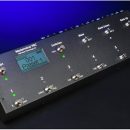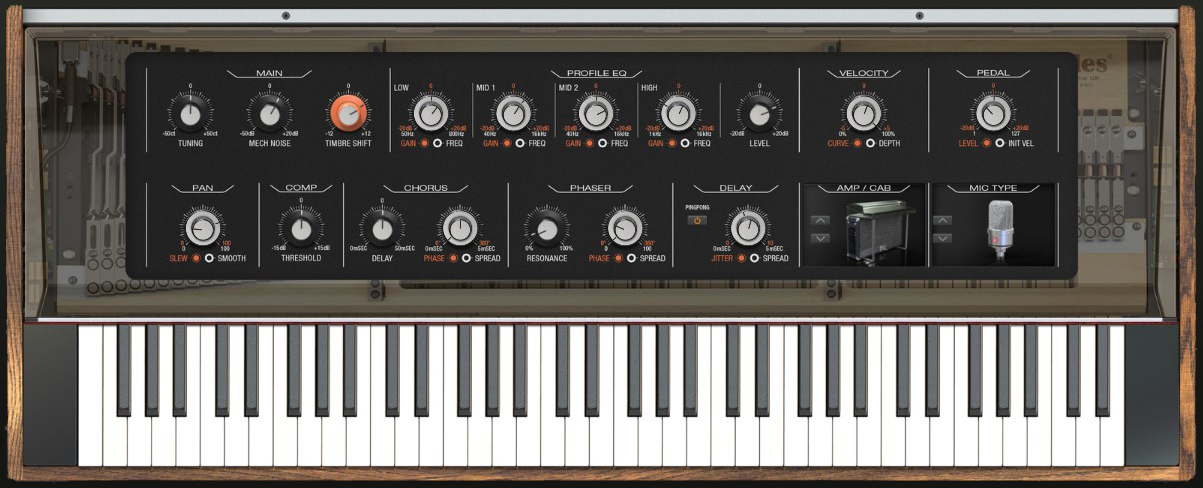When we were asked by Roland to review the RD-64, we admit it: we were a bit skeptical. After salivating over other products like the flagship RD-800, we weren’t sure what to make of this stage piano. Professional? Consumer? Toy? However, after putting it through its paces once it arrived, we were pleasantly surprised. The RD-64 sports 64 weighted keys, is very lightweight (only 28 pounds!), and is designed to deliver piano, clav, electromechanical piano, and organ sounds, all with a robust 128 voice polyphony.
| Category | Value | Rating |
| Features | 20% | |
| Usability | 25% | |
| Sound | 25% | |
| Documentation & Support | 10% | |
| Price | 20% | |
| OVERALL RATING = 3.4 3.6 stars or better: Outstanding, WIHO Award 3 stars or better: Worth considering 2 stars or better: Suited to specific needs 1 star or less: Not recommended |
||
As you only have twelve sounds on board, this is clearly not the keyboard for everyone. However, if you’re looking for a portable, nice-playing, good sounding, weighted-key, stage piano without all the trimmings, the Roland RD-64 may serve you well as part of your rig. It’s also a great option if you need a no-frills weighted keyboard controller for computer-based music production.
Features
The first thing you’ll notice about the Roland RD-64 is the keyboard. The RD-64 has a 64-note, Ivory Feel-G, full weighted keyboard. It’s an extremely rare treat to find a weighted keyboard in a device compact enough to fit on your studio desk, or a keyboard easy enough to gig with in the smallest venues.
As for what you can do with that weighted keyboard, let’s be clear: the Roland RD-64 is not meant to be a synth nor a workstation keyboard. Once you accept that, and see that it is designed to perform a limited number of things well, it makes a bit more sense.
To start, there are twelve sounds. On the left side of the keyboard is the control panel, and here you will find dedicated buttons for acoustic piano, electric piano, organ, and clav. Each category has three dedicated buttons to allow you to choose variances within each category, as not all pianos, etc., sound alike. In this control panel, there is also a button for reverb (which unfortunately can’t be incrementally adjusted, only On/Off), octave, transpose, and two effect buttons. There is also a two-band EQ section (bass and treble) and volume control.
 Given the range of bread-and-butter sounds, we found it surprising that there is no way to create splits or layers, which hardly matters for the piano and organ sounds on board, but this would have been useful when using the RD-64 to control external sound sources.
Given the range of bread-and-butter sounds, we found it surprising that there is no way to create splits or layers, which hardly matters for the piano and organ sounds on board, but this would have been useful when using the RD-64 to control external sound sources.
Roland has included a D-beam controller, which allows hand motions to alter the sound by assigning it to a specific parameter (i.e., volume, pitch, effect). While this can be fun to use with organ sounds, it is a surprising feature given the focus of this keyboard, though its inclusion makes more sense if you decide to use the RD-64 as a controller for something like the Roland Integra 7 sound module. Below this is the pitch bend and modulation wheel.
Finally, there is a SuperNATURAL button. SuperNATURAL has become Roland’s model for synthesis over the years. Pressing it while in regular playing mode doesn’t do anything, but apparently this is the button to press if you have a SuperNATURAL sound module or keyboard connected to the RD-64. The one-touch SuperNATURAL button automatically assigns the RD-64’s controllers to utilize the SuperNATURAL tones in Roland’s Integra-7 sound module as well as in the Jupiter-80/50 synthesizers. Think of this like a built-in template to easily control other modern Roland synths.
On a related note, if you power up the RD-64 while holding the Acoustic Piano button down, the keyboard enters a MIDI controller mode in which the internal sounds are disabled, and you can connect the keyboard to your computer directly via USB to control your soft synths (or to an iPad with Apple’s Camera Connector Kit).
Behind all this on the back are your ports: USB, MIDI Out (no In or Thru), damper, two other pedal controller jacks, audio out, audio in (just play-through, not for vocoding or sampling), power, and headphones.
Usability
The approach here is similar to Korg’s SV-1: pick your sound, tweak your effects, and play. This is one of the easiest to use keyboards you will ever find this side of an old, ‘80s Casio all-in-one. That, of course, is the result of limited controls and a limited selection of sounds. Fortunately, what the RD-64 does have inside is very good.
We liked the feel of the weighted keys, and the 64 keys are arranged similarly to a Wurlitzer 200a (ranging from low A to high C) — a nice detail. While the action was slightly stiffer than that of our studio’s Korg Triton LE 88 controller, it was in the same ballpark, and felt good. Unlike the Triton, the RD-64 has slightly textured keys, making it even more piano-like in feel. Additionally, there are five different velocity curve settings ranging from Super Light to Super Heavy to customize the response.
While a bit cumbersome, some editing is possible beyond the labeled button options. Holding down the Function button on the left panel plus one of the keys (various functions are printed above them, such as program change, velocity curve, etc.,) allows for more editing.
Sound
As mentioned previously, the RD-64 uses Roland’s Supernatural Sound engine, which is their current multi-sampled sound engine. And generally speaking, it sounds very good.
The acoustic piano category has three choices: concert piano, bright piano, and concert mono. Pressing the EFX 2 button activates damper pedal resonance, which adds a certain liveliness to the sound. There are no detuned or honky-tonk pianos here—these pianos are more clean and streamlined. No Yamaha CP sounds either, which was certainly not the end of the world, but would have been nice to have.
Electric pianos include two Rhodes sounds and one Wurly. There are also three Clav settings and three drawbar organ settings. The organs, while limited in number, and without drawbar controllers, are nevertheless nice sounding, and they include an adjustable two-speed rotary effect. There’s even overdrive, whose level could be adjusted in real-time from the D-Beam. Unfortunately, the RD-64 only recognizes an expression pedal when it’s in MIDI controller mode (which disables the internal sounds). The organ tones might have benefited from this type of control.
Overall, the acoustic pianos sounded very good, with the electric pianos being a close second. We would have loved the inclusion of an expanded, dedicated effects section for the electric pianos: chorus, phaser, delay, etc., as these effects were so much a part of the sound back in the day. Fortunately, the tremolo and phaser effects that are included do a nice job. The clavs sound good, but with only simple On/Off controls for essential effects like wah and overdrive, we couldn’t quite capture the classic tone we sought.
Documentation and Product Support
The RD-64 comes with a printed booklet of instructions, which is helpful, but realistically, things are so simple and straightforward in the RD-64 that you’re probably not going to need it much. There is additional info in the support area on the Roland website as well.
Price
The Roland RD-64 (MSRP $1,165) has a street price just under $1,000. This is a unique product to be sure: 64 weighted keys for a stage piano with pro piano sounds, electric pianos, clavs, and organs (although only twelve in total). The D-beam is an interesting, if not odd, inclusion, but it does allow for some potentially cool control functions when in MIDI controller mode. This keyboard won’t be everyone’s cup of tea given the limited sounds and functionality, but for a lightweight, good sounding stage piano with useful controller capabilities at a low price point, this may be just what many gigging musicians need.
Contact Information
Roland
www.Rolandus.com
| Evaluation Short-List |
|
















